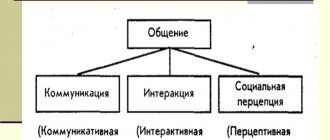Communication is a psychological definition of an important human need at any age. Thanks to him, people's activities are planned, controlled and carried out, friendly and loving relationships are established. For a more extensive understanding of this type of communication in psychology, sociology, social science and pedagogy, it is necessary to study what communication means, what its goals and functions are.
Communications in society
Communication from the perspective of psychology
The term “communication” refers to different forms of interaction between people, which are carried out using various sign means, such as:
- facial expressions;
- symbols;
- images.
The desire to contact another person arises from the need to act together.
Significance in psychology
To clearly understand what communication is, it is necessary to consider the various definitions of the term. They will help to form a multifaceted understanding of this method of communication:
- Human communication is considered in psychology to be a complex and multifaceted process that is aimed at establishing and developing contacts between a group of people.
- According to the literature on the culture of communications, communication is a unique process of exchanging the results of spiritual and mental activity between people. This may include assessments, thoughts, feelings, judgments, attitudes.
- Communication is also a basic psychological need of a person, which contributes to the formation of personality. In the process of interpersonal contacts, the subjective world of one individual opens up to another. This allows a person to self-determinate and self-present himself in society.
Number of participants in the communication process
Several people can take part in a conversation, but not all participants will communicate with each other.
- Personal-group or socially oriented - the initiator interacts with each member of the group. In the process, personal and group goals and objectives are formulated and reviewed. An example of personal-group communication is communication between a boss and his subordinates.
- Interpersonal or person-oriented - in the process of interaction with a person, the interlocutor seeks to get to know him better or obtain the necessary information. Participants in communication may view each other as equal partners or tools to achieve their goals.
- Intergroup - contact between two groups. Their goals and objectives may coincide, which will allow them to solve large-scale problems. Or the views are opposite, which will result in conflict. Examples of intergroup communication are sports fan meetings or graduation discussions between several classes. Each team member is the bearer of a group task and can defend the interests of all its members.
A person can interact with one interlocutor or a couple of people, or with a large number of others. Everything is determined by the goals and objectives of communication and the social status of the interlocutors.
The essence of communication, purpose, functions
Verbal communication - what is it in psychology
Sociologists believe that interpersonal communication is an excellent way to convey social experience and culture to other people. Domestic psychologists support the idea that the purpose of communication is to create unity between the exchange of information and activities in society. But it is unrealistic to make an exchange if there is no understanding between people, because it helps to achieve success and establish close contact.
Important! Therefore, understanding is the main goal of interpersonal contacts. The result of communications depends on it.
Communication goals
Communication in a person’s life performs 8 main functions.
Contact
To understand what the contact function means and why it is needed, it is enough to remember the main fear of a person - the fear of being misunderstood.
Important! This barrier prevents the establishment of close and long-term relationships with people.
The more one person communicates with another, the easier it is to establish contact between them and, as a result, understanding.
Information
The information function is responsible for the generation, transmission and reception of information. It is implemented in several stages:
- first, differences in the awareness of individuals who are aimed at entering into psychological contact are equalized;
- then beliefs, thoughts, facts are transmitted, and conclusions are drawn about what was heard;
- at the third stage, the desire to understand the interlocutor is formed.
This function of communication is important because messages, plans, decisions and opinions help to establish understanding between contacting entities.
Incentive
The incentive function allows you to stimulate a person to take active action. In this case, communication allows you to manage people.
Additional Information. In the modern world, this function is used in all areas of activity for manipulation.
Commercials are a prime example of successful implementation of a feature.
Coordination
The coordination function allows people to engage in joint activities. Thanks to it, a group of people can coordinate their actions and effectively complete the task. If the function is implemented poorly, such communication will bring disappointment and losses.
Emotive
Thanks to the emotive function, people are able to arouse the necessary emotional experiences in their partner, as well as change their own state.
Important! The transfer of emotions can occur both verbally and non-verbally.
If the methods of emotional regulation between partners are different, then the effective implementation of this function in communication will be impossible, and people will encounter misunderstandings and conflicts.
Understanding function
The terminology of the word “understanding” is associated with such concepts as “meaning” and “meaning”. Based on this, the main task of this function is to explain to the two people in contact the purpose of their communication, as well as the further development of events. Understanding also allows partners to get to know each other and predict the behavior, attitudes and state of the interlocutor in the future.
Influence function
The influence function is similar to the incentive function. Its main goal is to change the behavior, state, personal and semantic formations of the interlocutor.
Important! To implement the function, a variety of psychosocial influence techniques can be used. It can be used for both positive and negative purposes.
Ratio function
The relationship management function allows an individual to realize and fix his place in business, status, and interpersonal relationships. With its help, a person has his own circle of interests, important and necessary people, as well as acquaintances for specific matters.
Block 2. Purpose of communication. Differences in understanding words and phrases.
When a negotiator begins to talk to another person, verbalizes his thoughts, he strives to have a certain impact on the recipient of the message. This impact involves obtaining, achieving some result, which is a priority “HERE AND NOW”. The context in which communication occurs is important. The recipient of the message perceives the information sent to him, and often does not extract the meaning intended by the sender directly from concepts (“Is this a concept in logic? Aristotle’s logic is brief and clear!”), judgments (“Is this a judgment in logic? Complex judgments are examples. Classification of judgments”) , inferences (“Is this inference in logic? Is it deductive inference?”). Example:
Question:
– Sveta, under what conditions at the current interval of the historical process will the social behavior of an individual, subject to the influence of the state’s monetary policy, cease to be determined by the motivational-need components of the biological essence?
Answer:
– Sergey, I also think it’s important to be honest!
In the above dialogue, you can notice a discrepancy in meaning between the answer and the question asked. The question is formulated by the sender in a complex manner; it is a multi-level verbal construction. The meaning that Svetlana put into this question differs from the meaning that Sergei put into it. Svetlana, even if she understood the meaning of Sergei’s words, did not extract meaning from the connections between words in the same way as Sergei extracts meaning. As a result, the meaning of this question led to the formation of a meaning for Svetlana, which is significantly different from the meaning of Sergei’s message.
The meaning that people make based on their understanding of the message, i.e. understanding the meanings of even simple verbal constructions can differ significantly! This has to do with individual conceptual models of the world. This is where the saying “you and I speak different languages” comes from. Therefore, it is important to structure the negotiator’s speech in such a way that it is understandable to the opposite party. This is a complex process, so using interrogative sentences that incorporate the opponent's language patterns will be appropriate and appropriate.
You can see how to beautifully convey your idea to your opponent in negotiations in this video!
WATCH THE VIDEO “How to convince your boss to raise your salary?!”
Responsive WordPress Gallery Plugin
Types of communication
Nonverbal communication - what is it in psychology
The exchange of information between people can be extremely diverse. A communicative classification will help you understand what communication is, what its role is in society, and what types it comes in.
Types of communication
By content
When communication is built between people, defining its goals is the main task at the very beginning. Therefore, dividing communication by content makes it possible to establish the motives for contact. According to this classification, communication occurs:
- Activity. There is an exchange of skills, abilities, operations and actions between individuals.
- Motivational. With such communication, people exchange needs, interests, and motivations.
- Air-conditioned. Thanks to this type, one person is able to make an exchange of physiological and mental states.
- Cognitive. The main purpose of such communication is to transfer knowledge.
- Material. When communicating, people exchange products and objects.
By purpose
According to goals, communication is divided into 2 types:
- social, in which the goal is to expand and strengthen interpersonal contacts;
- biological, which is required by society for the support and development of the organism.
Via communication channel
According to the communication channel, communication is divided into the following types:
- Non-verbal. The exchange of information between people is carried out using gestures and facial expressions.
- Verbal. This channel of social communication is realized through speech.
- Artificial. Communication is carried out through unique amulets, tattoos, and symbols that have a certain meaning. This type also includes books, the press, telephones, television and radio broadcasting.
Affordable
By means of communication there are:
- Indirect. Communication is carried out with the help of intermediaries.
- Direct. Conversations between people take place in personal contact.
- Indirect. In this communication, various means and tools are used to exchange information between people. Social networks are a prime example of such communication.
- Direct. Communication occurs through natural organs, such as vision and hearing.
By contact
Depending on the contact with the interlocutor, communication can be:
- Indirect. This type of communication is considered indirect. Exchange between people occurs when they are distant from each other. For example, this is correspondence, telephone conversation.
- Direct. It is direct communication in which subjects are close to each other and exchange information using facial expressions, gestures and speech. This type is considered the most complete, since in the process individuals are able to gain maximum knowledge about each other.
According to the conditions of the situation
Depending on the situation, communication occurs:
- Official. Official communication is carried out exclusively in the business sphere. It is characterized by the presence of a large number of formalities and rules.
- Unofficial. Private communication is not limited to a set of rules. It can happen in any area.
Content component of the communication process
Communication is a way to convey information to others. Therefore, one of the classifications is based on the content of statements.
- Material - in addition to verbal skills, material objects are exchanged for the implementation of any activity. Material communication often occurs between close people, for example, the transfer of household items or purchases in a store. The purpose of such interaction is to satisfy urgent human needs.
- Cognitive serves to transmit various information. Aimed at broadening horizons and sharing experiences. During the conversation, skills and abilities can be discussed. More common in professional environments.
- Conditioning - aimed at influencing the emotional state of a person. Manifests itself as providing moral support and consolation.
- Motivational - goal - motivating a person to perform actions, achieve goals.
- Activity - combines communication and implementation of practical actions. In the process of such communication, experience, skills and abilities are exchanged.
Several types are often combined: it all depends on the degree of closeness of people and the type of their relationship.
Features of communication
Functions of communication in psychology and their brief description
After the term “communication” has become clear, what it is and what it is needed for, it’s time to study its features. They will help you build proper communication:
- For quality communication, the presence of two active individuals is necessary.
- During a conversation, it is necessary to have mutual influence on each other, both emotional and physiological.
- Partners must have a single or similar information exchange system.
- When communicating, there must be room for communication barriers to arise.
Basic Rules
In addition to these norms, there are social rules that can improve communication between people.
Classification according to E.I. Rogov
E.I. Rogov identifies 3 dominant types of social interaction: imperative, manipulative and dialogical.
Imperative
In the psychology of communication it is called authoritarian or directive. It is based on the desire of one person to subjugate another. This manifests itself in the desire to control his thoughts and behavior in order to perform the necessary actions.
An authoritarian personality does not view their partner as a person with their own opinions and emotions. In imperative communication, a person does not hide his desire to subjugate another.
Manipulative
It has similar features to directive. His goal is similar, but the manipulator hides his true intentions. The partner is perceived as a person who has the necessary skills and qualities.
Manipulators often become victims of the communication they choose. He begins to perceive himself as one of the participants and his actions are assessed from the outside. A person becomes confused in his intentions and loses his inner core. The manipulator is characterized by deceit, constant self-control, loss of interest in the environment, a cynical attitude, mistrust and boredom.
Psychologists distinguish 4 types of manipulative communication:
- active - management is carried out through active influence. A person takes advantage of his social status. His main life principle is to be in charge everywhere and manage everyone;
- passive - the manipulator plays the role of the helpless, allowing people to provide him with help and support. Adheres to the principle of not annoying others;
- competitive - for a person, life is associated with constant competition, a chain of victories and defeats. He sees himself as a fighter, so those around him are perceived as potential rivals and enemies. His main life goal is to win at any cost;
- indifferent - the manipulator portrays detachment, indifference, and therefore tries to avoid social contacts. Uses alternately active and passive means. Tries to reject the care of others.
Psychologists classify imperative and manipulative types of communication as monologue. A person views his interlocutor as a tool to achieve a goal, ignoring his emotions and desires. Therefore, the manipulator communicates with his own tasks and goals.
Dialogical
This form is the opposite of the imperative and malipulative options, because it is based on the equality of its participants. It is based on humanistic principles and in dialogue the interlocutors try to achieve mutual understanding and get to know the other person better. To implement a dialogic form of communication, a number of conditions must be met:
- attuned to the emotions and psychological state of oneself and the interlocutor;
- trust in the interlocutor without assessing his personality;
- participants in the dialogue perceive each other as equal interlocutors with the right to their own opinion. Each of them recognizes the other's right to make decisions;
- during the conversation, participants look for common problems and unresolved issues;
- communicating with a person on one’s own behalf, expressing one’s thoughts and feelings.
Dialogue is considered the perfect form of communication, which allows you to reveal a person’s character and establish trusting relationships on a deep level. A person must be psychologically prepared for such interaction and perceive the interlocutor as an equal participant in the dialogue.
Rules of communication (communication)
To prevent interpersonal relationships with friends, colleagues or a loved one from deteriorating over time, you need to learn the basic rules of communication:
- To create a trusting and informative conversation, visual contact is necessary.
- It is advisable to speak only to the point. Expressions that do not carry any semantic meaning should be excluded from the vocabulary.
- The conversation must always be maintained by asking questions and clarifying information.
- To keep the conversation going, you need to answer in detail. It is better to exclude monosyllabic and simple answers when speaking.
- You should not use words unknown to the interlocutor. The language and reasoning must be understandable to both.
- A good mood is the key to an interesting conversation. Even a business meeting could use a little humor and smiles.
- There should be no things in your hands during a conversation. They can take the interlocutor's attention to themselves.
- Pauses during conversation are insidious enemies. Long silence (more than 10 seconds) will cause discomfort.
Communication between a person and another individual is an art that anyone can master if they follow the above recommendations.
How to communicate with impossible people
Difficult people require a special approach during conversation. If you need to contact an unpleasant person, you can minimize the receipt of negative emotions using 5 basic rules:
- You should not take your opponent’s criticism or advice that you haven’t asked for personally.
- If your interlocutor likes to interrupt, you should not allow him to do so. This requires politely explaining to the person that his arguments will not be heard until the speech is finished.
- If the interlocutor does not want to talk, but you need to get an answer from him, in this case the best communication is to briefly state the essence of the question.
- We should not forget about the ability to listen to your opponent. Thanks to an attentive attitude towards the interlocutor, respect for his words and thoughts will be visible.
- There is no need to teach a person to communicate if he does it somehow wrong. Each individual has his own way of speaking. Therefore, an evaluative conversation will only irritate.
Communication is the key to the whole world. Careful study of the operating instructions and proper use will make it easier to achieve your goals.










